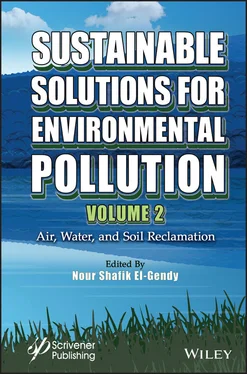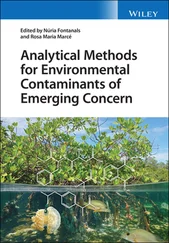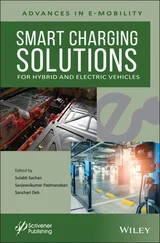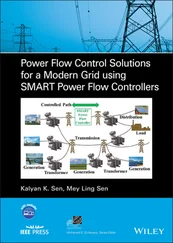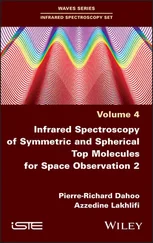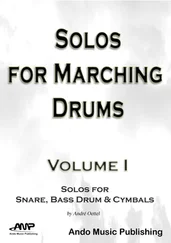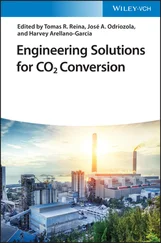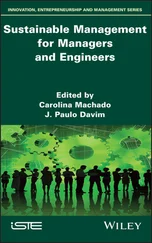Sustainable Solutions for Environmental Pollution, Volume 2
Здесь есть возможность читать онлайн «Sustainable Solutions for Environmental Pollution, Volume 2» — ознакомительный отрывок электронной книги совершенно бесплатно, а после прочтения отрывка купить полную версию. В некоторых случаях можно слушать аудио, скачать через торрент в формате fb2 и присутствует краткое содержание. Жанр: unrecognised, на английском языке. Описание произведения, (предисловие) а так же отзывы посетителей доступны на портале библиотеки ЛибКат.
- Название:Sustainable Solutions for Environmental Pollution, Volume 2
- Автор:
- Жанр:
- Год:неизвестен
- ISBN:нет данных
- Рейтинг книги:3 / 5. Голосов: 1
-
Избранное:Добавить в избранное
- Отзывы:
-
Ваша оценка:
- 60
- 1
- 2
- 3
- 4
- 5
Sustainable Solutions for Environmental Pollution, Volume 2: краткое содержание, описание и аннотация
Предлагаем к чтению аннотацию, описание, краткое содержание или предисловие (зависит от того, что написал сам автор книги «Sustainable Solutions for Environmental Pollution, Volume 2»). Если вы не нашли необходимую информацию о книге — напишите в комментариях, мы постараемся отыскать её.
This second volume in a broad, comprehensive two-volume set, “Sustainable Solutions for Environmental Pollution”, concentrates on air, water, and soil reclamation, some of the biggest challenges facing environmental engineers and scientists today.
AUDIENCE: Sustainable Solutions for Environmental Pollution,
Sustainable Solutions for Environmental Pollution, Volume 2 — читать онлайн ознакомительный отрывок
Ниже представлен текст книги, разбитый по страницам. Система сохранения места последней прочитанной страницы, позволяет с удобством читать онлайн бесплатно книгу «Sustainable Solutions for Environmental Pollution, Volume 2», без необходимости каждый раз заново искать на чём Вы остановились. Поставьте закладку, и сможете в любой момент перейти на страницу, на которой закончили чтение.
Интервал:
Закладка:
With the global water scarce problem, available water resources are exposed to many industrial and agricultural effluents, sudden occurrence of oil spills, contaminants from shipping and trading activities, and the uncontrolled massive discharge of plastic and food wastes. Consequently, it becomes contaminated by organic and inorganic pollutants, heavy metals, plastic debris and other solid wastes. Those negatively affect the life underneath water, fish population, coral reefs, aquatic biodiversity, coastal areas and touristic activities, besides, algae which produce approximately 50% of the atmospheric oxygen with the simultaneous photo-autotrophic consumption of GHG-CO 2and also lead to extinction of some aquatic inhabitants.
Soil pollution can occur from oil industrial activities, uncontrolled use of pesticides and fertilizers, leachates of heavy metals and other xenobiotics from municipal wastes landfills. It is a real threat as such pollutants would present in agricultural systems, crops and plants, reach directly to human through food chain and indirectly through the intake of meat and milk products from animal and cattle accumulated such pollutants in their organs via the up-taking of polluted plants and crops.
The use of nature-based solutions (NBSs) as sustainable and greener option for management and remediation of polluted sites and upgrading of oil products are not only an environmental preference, but they are also a strategic worldwide choice in the modern economy. Thus, bio-based practices, for example; phyto- and bio- remediation, biosorption, biodesulfurization, etc., are denoted as promising, ecofriendly, economic and impactful techniques than the conventional physical and chemical processes.
This book interprets and links various sources of environmental pollution with different human activities and industrialization. It covers the basic concept of bio- and phyto- remediation and most up-to-date solutions for remediation of polluted environment; air, water, and soil from organic and inorganic pollutants and pathogens. It expounded the development of phycoremediation, electro-bioremediation based on a passive redox control of microorganisms, constructed wetlands, the promising biosurfactants, the biosynthesis of metal oxide nanoparticles and their applications for environmental reclamation, novel membranes catalytic reactors and sand filtration in addition to recyclable porous adsorbents for capturing GHG and other applicable biosorbents for water treatment from polluting heavy metals and other organic pollutants. It goes through the bio-upgrading of crude oil and its fractions to indirectly overcome air pollution and mitigate the problem of climate change. It elucidated some case studies for environmental reclamation and discusses also challenges and opportunities of the implementation of such natural based solutions to reach a clean and sustainable environment.
The chapters are: Chapter 1- Natural-Based Solutions for Bio-Remediation in Water Environment; Chapter 2- Removal of Heavy Metals from the Environment by Phytoremediation and Microbial Remediation; Chapter 3- Bioremediation as a Sustainable Solution for Environmental Contamination by Petroleum Hydrocarbons; Chapter 4- Pollution Protection Using Novel Membranes Catalytic Reactors; Chapter 5- Removal of Microbial Contaminants from Polluted Water Using Combined Biosand Filters Techniques; Chapter 6- Biosurfactants: Promising Biomolecules for Environmental Clean-up; Chapter 7- Metal Hyper-accumulation in Plants: Biological Mechanisms and Phyto-technologies; Chapter 8- Microbial Remediation Approaches For PAH Degradation; Chapter 9- Biomorphic Synthesis of Nanosized Zinc Oxide for Water Purification; Chapter 10- Pollution Dynamics of Urban Catchments; Chapter 11- Bioupgrading of Crude Oil and Crude Oil Fractions; Chapter 12- Recyclable Porous Adsorbents as Environmentally Approach for Greenhouse Gas Capture.
The discussed multidisciplinary sustainable approaches in this book for environmental reclamation highlighted the importance of scientific and engineering disciplines to reach all other disciplines including economics, politics and other social sciences. Accordingly, it is time for interdisciplinary efforts from chemists, biologists, microbiologists, ecologists, mathematicians, statisticians, engineers, medical doctors, economists, politicians, and military officers, governmental and non-governmental organizations to put hand to hand together for recruitment of all available resources for the reclamation of environment from air, water and soil pollutants to achieve the three pillars of sustainability: economic, environmental, and social.
Nour Sh. El-Gendy
1
Natural-Based Solutions for Bioremediation in Water Environment
Pascal Breil1, Marie-Noëlle Pons2, Gilles Armani1, Ranya Amer3, Harrison Pienaar4, Paul Oberholster5 and Philippe Namour1*
1 INRAE, Centre Lyon Grenoble, Auvergne Rhône-Alpes, rue de la Doua, Villeurbanne, France
2 CNRS-Université de Lorraine, Laboratoire Réactions et Génie des Procédés, rue Grandville, Nancy Cedex, France
3 City of Scientific Research and Technology Applications (SRTA-City), Department of Environmental Biotechnology, New Borg El Arab, Alexandria, Egypt
4 Council for Scientific and Industrial Research (CSIR), Smart Places, Pretoria, South Africa
5 University of the Free State, Centre for Environmental Management Faculty, Natural and Agricultural Sciences, Bloemfontein, Republic of South Africa, Hebei University of Engineering, Handan, People's Republic of China
Abstract
The search for effective and sustainable techniques for the decontamination of polluted water bodies has led to significant progress over the last two decades with the emergence of the concept of bioremediation, i.e., the use of nature-based solutions (NBSs) to eliminate pollution. The sustainability of these processes is based on the availability of low-cost resources and community-wide acceptance of NBSs. The chapter begins presenting (1) the basic concepts of bioremediation in freshwater ecosystems, based on NBSs, and (2) the details about aquatic bioremediation structures used. It discusses (3) the different techniques and plants used, with published results in phycoremediation (4) and phytoremediation (5), followed by improvement of bioremediation (6), with physical-chemical and microbial activity stimulation techniques, and the development of electro- bioremediation based on a passive redox control of microorganisms. Then, it deals with the maintenance and biodiversity of constructed wetlands (CWs), (7 and 8) and the possible nuisances to be controlled. Finally, it deals with monitoring (9) and modeling of CWs (10). The chapter ends with the social acceptance of the installations in the landscape and the concepts used to integrate them at catchment scale (12). Case studies of applications in the field are used to illustrate the various points of the topic. The conclusion summarizes the important points and traces the directions for future progress. A bibliography, mostly published over the last 20 years but not exhaustive, completes the chapter.
Keywords: Self-purification, eco-hydrology, constructed wetland, phytoremediation, bank filtration
1.1 Introduction
Modern global lifestyle contaminates almost all compartments of the water cycle, both surface and groundwater, with organic matter (OM), nutrients, metals, as well as synthetic chemicals. Domestic and industrial wastewater discharges many endocrine disruptors as well as metals and pharmaceutical residues. Thus, minerals and organic components from domestic, agricultural, or industrial activities pollute water bodies. At the end of the 20th century, environmental degradation due to human activities led to awareness about the existence of societal benefits derived from ecosystems: ecosystem services. The impacts on ecological services could be ignored as long as the resilience of the ecosystems allowed it. However, the ecological footprint of human activity continues to grow. Local and reversible impacts have become global and difficult to reverse, revealing the limits of ecological systems to support human activity, with negative cascading effects, when alteration on one ecosystem service has negative consequences on one or more other services. A well-known example is that of water resources and their pollution. The European Water Framework Directive 2000/60/EC was a first level of response aimed at reducing the ecological footprint (WFD, 2000).
Читать дальшеИнтервал:
Закладка:
Похожие книги на «Sustainable Solutions for Environmental Pollution, Volume 2»
Представляем Вашему вниманию похожие книги на «Sustainable Solutions for Environmental Pollution, Volume 2» списком для выбора. Мы отобрали схожую по названию и смыслу литературу в надежде предоставить читателям больше вариантов отыскать новые, интересные, ещё непрочитанные произведения.
Обсуждение, отзывы о книге «Sustainable Solutions for Environmental Pollution, Volume 2» и просто собственные мнения читателей. Оставьте ваши комментарии, напишите, что Вы думаете о произведении, его смысле или главных героях. Укажите что конкретно понравилось, а что нет, и почему Вы так считаете.
